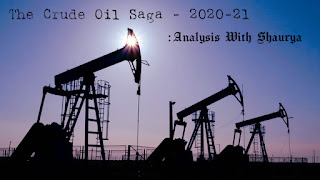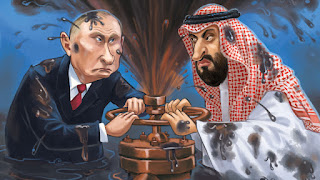The Crude Oil Saga 2020-21
Even after
several decades of First Oil Crisis and a lot of technological advancement … an
increase in petrol and diesel prices still effects balance of payments of
several nations and a common man's budget too.
“Economics
is study about how to meet unlimited need with scarce resources” – Laurence J
Peter.
This
statement holds a lot of significance. People make a lot of money by
manipulating prices (meeting their unlimited needs) via artificially adjusting
demand and supply (scarce resources) be it stocks, onions or crude oil… etc.
In this article we will see how demand and supply of crude oil were
adjusted so as to control prices.
We can
consider Petrol and Diesel as a relatively inelastic market in short run, which
means that there are very few substitutes available so that you can shift to
that substitute if prices for petrol increase.
As petrol
and diesel both are obtained from crude oil, so it becomes important to
understand about what happened to crude oil prices which were less than $30 in
early 2020 and then it astonishingly rose to $80 and above in 2021.
Abbreviations:
1. Barrels: quantity measure of crude oil
2. All prices are in $ per barrels
3. OPEC - organization of oil exporting countries
4. OPEC+ - includes Russia and some other nations too.
1 Outbreak of Covid-19 &
Saudi-Russia Dispute – A Price War
As the deadly corona virus started spreading all over the world, the
nations preferred life over economic growth and lockdowns were imposed in many
parts of the world. This led to a huge decrease in demand for crude oil &
massive losses for the OPEC+ nations as they have crude oil as an important
source of income.
On one hand the decrease in demand for crude oil was leading to a
massive decrease in crude oil prices and on the other hand Russia rejected the
demand by Saudi Arabia to cut oil production. This led to a price war between
Russia and Saudi Arabia. As Saudis have a break even point of even less than
$10 per barrel (although this led to huge budget deficits), they increased
their oil production and even offered price discounts to its customers from
April.
As per some analysts Russia has break-even point at around $30 per
barrel, which means it can’t continue its production at a price of less than
$30 per barrel. The daunting steps taken by Saudis were causing severe losses
to Russia as this price war crashed the crude oil prices to around $24 per
barrel.
On the other hand, White House was also suffering because USA has shale
oil reserves. The shale oil has high extraction and production cost. The shale
oil companies in USA can’t operate with prices less than $30-$40 per barrel.
This means that if the price of crude oil will go below $40 per barrel, it will
lead to shut down of America’s shale oil production in short run. One reason is
that they will incur loss and the other is that shale oil is priced lesser than
crude oil, so if crude oil is less than $40, buyers will not prefer to buy
shale oil for a higher rate than crude oil.
Saudi Arabia is a good ally of USA, this was the main reason why Saudis
were proposing to cut oil production so that the price of crude oil will remain
higher and America’s shale oil production will continue. Russia foresaw this
and rejected the Saudis demand to cut oil production. But due Saudis offering
discounts and crude prices less than $24 per barrel Russia had to agree to cut
oil production.
Some experts say that Donald Trump called emperor of Saudi Arabia
“Mohmad bin Salman” and threaten him that if he did not cut production and
continue this price war, he will impose sanctions on Saudis and withdraw US
army from Riyadh.
After all this both the parties (Saudi & Russia) agreed to cut oil
production and the crude oil prices started normalizing.
How cut in production effect Crude
Oil prices?
A cut in production led to decrease in supply, which means shortage of crude
oil as compared to its demand, this led to increase in crude prices after a
sharp fall.
2- Crude at its peak – Output Cuts
& Demand Recovery
As the situation started getting stabilized with an increase in vaccination
doses, the demand for crude oil started increasing. Now on one hand there were
production cuts as decided in OPEC+ meetings and on the other hand there was an
increase in demand for crude oil. This led to a massive rise in crude oil
prices. This became catastrophic for nations importing oil.
Although OPEC+ decided to increase production by 400000 barrels per day but
this was not enough to meet the demand and cool down the prices.
How increase in demand effect crude oil prices?
An increase in demand with production remaining same means there will be
shortage of a product, therefore prices go up.
Here also America intervened because with winters approaching, the fuel
demand in USA was also increasing and with elections (in some parts) being
scheduled in USA in Jan 2022, rising electricity bills and fuel costs may cost
Joe Biden a huge loss. Therefore, White House
asked OPEC+ to increase the oil production but OPEC+ didn’t increased
production beyond 400000 barrels a day.
This led to one of the fanciest things, which has happened only in big
circumstances like gulf war 1991 and Libya war 2011, ‘the release of oil
reserves.’
Following is the price chart of WTI crude oil prices, I have marked
three points, the first is related to our very first point i.e., Covid outbreak
and Saudi-Russia Dispute. The second point in related to second point (rise in
crude oil prices) and the third point is the fall in price after Reserve
release by United States.
3- Reserve release by Nations – Supply
emergency or Political emergency?
After the 1970’s embargo, many nations started maintaining crude
reserves- SPR (Strategic Petroleum Reserve). United States decided to release
50 million barrels of crude oil from its SPR and asked other nations also to
release some of their oil reserves.
Now before going further, let us understand:
What is the affect of releasing oil reserves?
By releasing oil reserves, the availability of crude oil in market will
increase. Therefore, the unmet demand or the shortage will be met and hence
prices will decrease. However, the magnitude of this effect is dependent on the
quantity being released.
US asked other nations like India, UK, Japan, South Korea and China to
release some of their reserves. India has already released 5 million barrels
from its reserves (India maintains a reserves of 9.5 days as a part of its
SPR). Japan has agreed but it will not release its reserve for manipulating the
prices as its law doesn’t allow this but they may release some part of their
reserve primarily to meet the demand.
Another Question here comes that:
How USA was able to take big nations on its side…. China too...?
One thing from my whole analysis on this topic was very clear that
United States is an excellent negotiator. They are excellent politicians and
they know very well how to make their nation and their people better off.
US targeted major oil importing nations i.e., China, India, Japan, South
Korea etc.
The US shale oil, as I said has huge refining cost as compared to the
traditional crude oil but it is available at a cheaper rate than the
conventional crude oil. With India and China facing huge problems due to rising
petrol and diesel prices, these two were the easiest ones to crack the deal.
Much of the US reserve release will be going to India and China, so taking
these two nations on its side became easier for USA.
In a similar fashion United States tackled other oil importing nations
but having India and China on their side made them totally confident of
capitalizing their motives behind reserve releasing step.
On 26-11-2021, United States released 50-million-barrel crude oil from
its reserve. This led to a massive decrease in crude oil prices, or we can say
the worst fall in crude oil prices from $78 to $68 in 2021 (about 13%). It fell
till $65.4 on 01st of December 2021.
4- Reaction of OPEC
OPEC had all reasons to cut production after US led reserve release but
US officials had met with UAE and Saudi Arabia’s officials before OPEC’s
meeting on 2nd of December 2021. The end result of the meeting was
that OPEC+ sustained their decision of increasing supply by 400000 barrels per
day.
What if Russia had demanded
production cuts as it knew that high crude oil prices will affect USA?
Saudi Arabia is the “Hukum ka Ekka” for united states in middle east and
OPEC related matters, well US can influence UAE too to be on their side. If
Russia would have demanded to cut production, US could have simply asked Saudi
Arabia to offer discounts in short run or it may have itself released more
reserves (which would have led to further sharp fall in crude oil prices). Any
of this step would have affected Russia.
As per analysts everything is good for Russia if prices are around $75.
5- Denouement – Summing up the Events
The whole game was neither orchestrated Russia nor by Saudi Arabia… it
was done by United States. When USA wanted to benefit their shale oil firms,
they get their task done by help of Saudis. And when USA wanted to cool down
the rising price, they get it done by their effective communication and
influencing power.
United States has no doubt won in this case but the truth is that
everything from here depends on how does the new variant i.e., Omicron affects.
OPEC+ may have decided to increase their production this is primarily because
they assume new covid variant to be a short-term effect (as officially stated
by OPEC+) but if demand for crude oil plunges OPEC+ will cut its production.
This means that if Omicron will harm the same way like 2nd
wave, Petrol and Diesel prices will soar like never before. With Crude at
around $75, we are having petrol prices at ₨95 (after
reduction in excise duty by Rs5) in India. If the situation became worse like
it was, Crude oil may rise to $90-$100 which will lead to petrol prices in
India at Rs 125 per liter or even more.
: Shaurya Gupta
Bcom Hons. University of Delhi
Financial Markets hons, Yale University






Excellent analysis in easy way.
ReplyDeleteThank you very much...
Delete